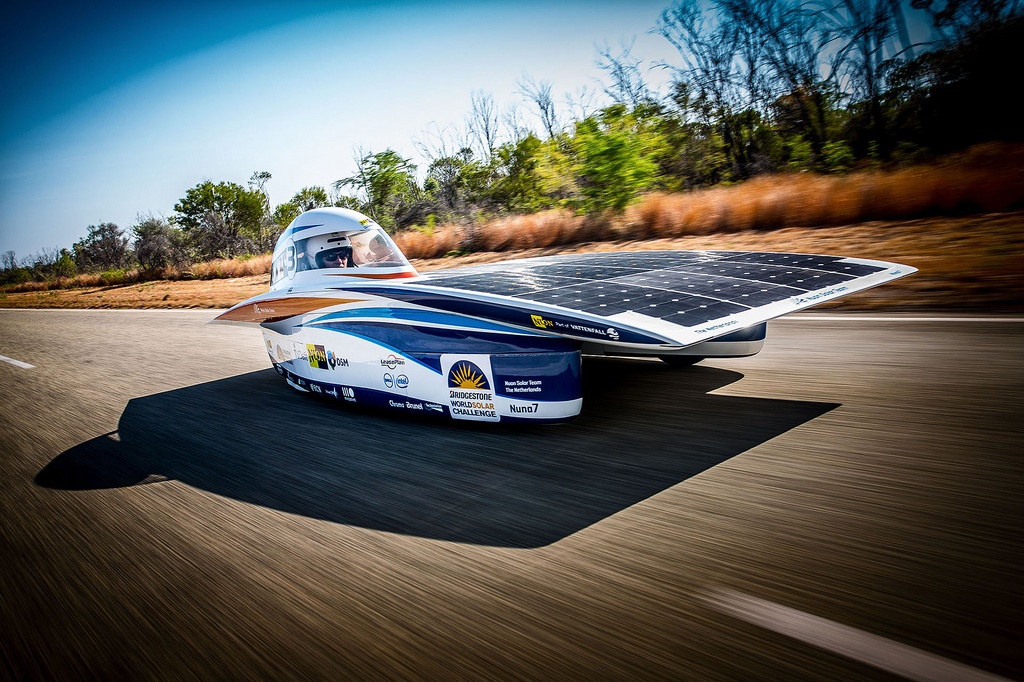Solar Powered Cars Race Across the Australian Outback
Language
Reading Level
Listen to Article

Despite technological advances in fuel and engine efficiencies, vehicles remain high on the list of polluters. In the U.S alone, carbon emissions from gas-powered cars and other vehicles account for about 27% of our total greenhouse-gas output annually. The 'World Solar Challenge' hopes to change that some day with cars fueled by our biggest, cleanest and cheapest source of energy - The sun!
The competition challenges universities and technical institutions to design and compete solar-powered vehicles in races across the Australian Outback all the way from Darwin to Adelaide, a distance of 3,000 km (2,896 miles). Started in 1987 by Australians Hans Tholstrup and Larry Perkins, the challenge is held every two years. This year's event that took place the week of October 18th - 25th attracted 40 teams of young engineers from 25 nations around the world.

Though the first competitions focused on vehicles powered exclusively by the sun, the scope has been now broadened to include energy efficient electric cars as well. However, it is still the solar-powered cars that attract the most attention because they are the most technologically advanced and pretty radical looking.
This year's top two in that solar-powered category came from the Netherlands.The Nuon Solar team from the Delft University of Technology took the gold. This was the team's sixth win since they began entering the challenge in 2003. The asymmetrical Nuon8 was not only 40 kg (88 lbs) lighter than its predecessor Nuon7, but also, more efficient at charging itself kinetically via static energy. Its solar panels sat atop the vehicle's extended 'duck beak-like' front section, allowing for efficient energy absorption, while minimizing wind resistance.
Though the Dutch team did eke out a win, it was not easy. In previous competitions, they had managed to outpace competitors by several hours. This year, their Nuon8 arrived at the finish line just three minutes ahead of second-place winner, Red One! The Nuon Solar team later said that they were not even sure they would be able to finish the race let alone win it, thanks to a dense cloud cover that prevented the solar panels from charging during the last leg of the contest.

While ‘Red One’ that was built by students from Saxion and the University of Twente may have missed the win, it was the crowd favorite when it came to style. Not only did it look like a pure racer, but it also had the technical specifications to match. With 98% motor efficiency (compared to just 25% for a traditional fuel engine), it was both economical and clean. Made from light carbon and aluminum, the 108-pound car was asymmetrical in design, with solar cells affixed to the wing and tail that jutted out from the side and the back of the cockpit.
Japan's Tokai University, which won the challenge in 2009 and 2011, came in third. The 'Tokai Challenger' that featured a high-efficiency motor, an ultra-light carbon body, and low resistance tires performed to its designer's expectations. In fourth place was University of Michigan's 'Aurum.' The yellow and blue speedster had an asymmetrical shape with a small cockpit over the right wheel-well. The team said their primary goal was to build a reliable and safe vehicle.
All in all, the winning vehicles averaged speeds of about 60 miles per hour over the 1,800-mile distance. This is an impressive feat for alternative energy vehicles, especially given that the contest regulations limit cars to just 6 square meters of solar paneling material.

Unfortunately, none of these cool concept cars are expected to be available anytime soon. The organizers of the World Solar Challenge say their primary goal is to bring together the brightest minds in solar and other sustainable energy design to inspire and challenge each other. They hope that some of the ideas used in these cutting-edge vehicles will be adopted to make currently available cars more energy efficient and 'greener.' Hopefully, as the technology and design improve, we may someday be able to replace our gas-guzzling cars with these way cooler 'green' vehicles!
Resources: fastcoexist.com,worldsolarchallenge.org,nuonsolarteam.com,sunisthefuture.net, guardian.com
Cite Article
Geography
Learn Keywords in this Article
732 Comments
- basketballanimeabout 3 yearswow! follow me if the car is amazing
- kuherimy-163519905676over 3 yearsTHAT IS SO COOL!!!
- jkbearover 4 yearscool
- fate34about 5 yearsI NEED ONE👌
- char char trainalmost 6 yearsthats so cool
- iliketrainsalmost 6 yearsI never knew cars could be so cool!
- oh im herealmost 6 yearsi wonder who will win this year
- HELLOalmost 6 yearsThis race is so cool
- Dalton Iversonalmost 6 yearsSo interesting
- natealmost 6 yearsvery cool